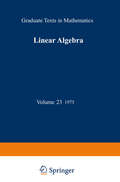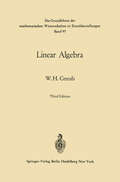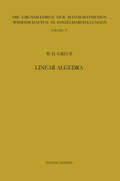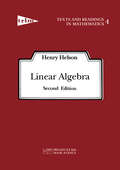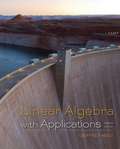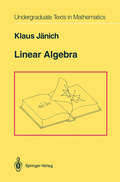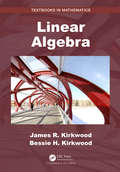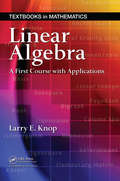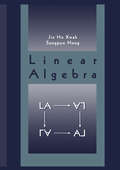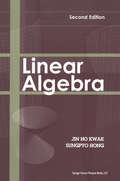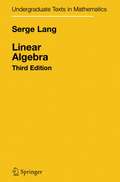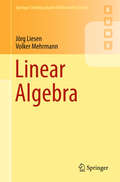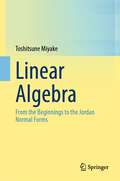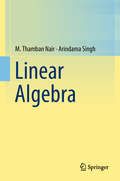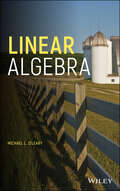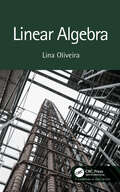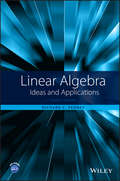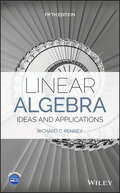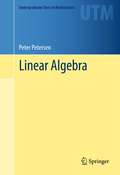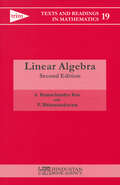- Table View
- List View
Linear Algebra (Graduate Texts in Mathematics #23)
by Werner H. GreubThis textbook gives a detailed and comprehensive presentation of linear algebra based on an axiomatic treatment of linear spaces. For this fourth edition some new material has been added to the text, for instance, the intrinsic treatment of the classical adjoint of a linear transformation in Chapter IV, as well as the discussion of quaternions and the classifica tion of associative division algebras in Chapter VII. Chapters XII and XIII have been substantially rewritten for the sake of clarity, but the contents remain basically the same as before. Finally, a number of problems covering new topics-e.g. complex structures, Caylay numbers and symplectic spaces - have been added. I should like to thank Mr. M. L. Johnson who made many useful suggestions for the problems in the third edition. I am also grateful to my colleague S. Halperin who assisted in the revision of Chapters XII and XIII and to Mr. F. Gomez who helped to prepare the subject index. Finally, I have to express my deep gratitude to my colleague J. R. Van stone who worked closely with me in the preparation of all the revisions and additions and who generously helped with the proof reading.
Linear Algebra (Grundlehren der mathematischen Wissenschaften #97)
by Werner H. GreubThe major change between the second and third edition is the separation of linear and multilinear algebra into two different volumes as well as the incorporation of a great deal of new material. However, the essential character of the book remains the same; in other words, the entire presentation continues to be based on an axiomatic treatment of vector spaces. In this first volume the restriction to finite dimensional vector spaces has been eliminated except for those results which do not hold in the infinite dimensional case. The restriction of the coefficient field to the real and complex numbers has also been removed and except for chapters VII to XI, § 5 of chapter I and § 8, chapter IV we allow any coefficient field of characteristic zero. In fact, many of the theorems are valid for modules over a commutative ring. Finally, a large number of problems of different degree of difficulty has been added. Chapter I deals with the general properties of a vector space. The topology of a real vector space of finite dimension is axiomatically characterized in an additional paragraph.
Linear Algebra (Grundlehren der mathematischen Wissenschaften #97)
by Werner H. GreubBesides the very obvious change from German to English, the second edition of this book contains many additions as weil as a great many other changes. It might even be called a new book altogether were it not for the fact that the essential character of the book has remained the same; in other words, the entire presentation continues to be based on an axiomatic treatment of linear spaces. In this second edition, the thorough-going restriction to linear spaces of finite dimension has been removed. Another complete change is the restriction to linear spaces with real or complex coefficients, thereby removing a number of relatively involved discussions which did not really contribute substantially to the subject. On p.6 there is a list of those chapters in which the presentation can be transferred directly to spaces over an arbitrary coefficient field. Chapter I deals with the general properties of a linear space. Those concepts which are only valid for finitely many dimensions are discussed in a special paragraph. Chapter 11 now covers only linear transformations while the treat ment of matrices has been delegated to a new chapter, chapter 111. The discussion of dual spaces has been changed; dual spaces are now intro duced abstractly and the connection with the space of linear functions is not established untillater.
Linear Algebra (Texts and Readings in Mathematics #4)
by Henry HelsonLinear Algebra is an important part of pure mathematics, and is needed for applications in every part of mathematics, natural science and economics. However, the applications are not so obvious as those of calculus. Therefore, one must study Linear Algebra as pure mathematics, even if one is only interested in applications. Most students find the subject difficult because it is abstract. Many texts try to avoid the difficulty by emphasizing calculations and suppressing the mathematical content of the subject. This text proceeds from the view that it is best to present the difficulties honestly, but as concisely and simply as possible. Although the text is shorter than others, all the material of a semester course is included. In addition, there are sections on least squares approximation and factor analysis; and a final chapter presents the matrix factorings that are used in Numerical Analysis.
Linear Algebra: with Applications
by Jeffrey HoltNow in its 2nd edition, Linear Algebra with Applications blends computational and conceptual topics to prepare students for the rigors of conceptual thinking in an abstract setting. The early treatment of conceptual topics in the context of Euclidean space gives students more time, and a familiar setting, in which to absorb them. This organization also makes it possible to treat eigenvalues and eigenvectors earlier than in most texts. Abstract vector spaces are introduced later, once students have developed a solid conceptual foundation. Concepts and topics are frequently accompanied by applications to provide context and motivation. Because many students learn by example, Linear Algebra with Applications provides a large number of representative examples, over and above those used to introduce topics. The text also has over 2500 exercises, covering computational and conceptual topics over a range of difficulty levels.
Linear Algebra (Undergraduate Texts in Mathematics)
by Klaus JänichThis book covers the material of an introductory course in linear algebra. Topics include sets and maps, vector spaces, bases, linear maps, matrices, determinants, systems of linear equations, Euclidean spaces, eigenvalues and eigenvectors, diagonalization of self-adjoint operators, and classification of matrices. It contains multiple choice tests with commented answers.
Linear Algebra (Textbooks in Mathematics)
by James R. Kirkwood Bessie H. KirkwoodLinear Algebra, James R. Kirkwood and Bessie H. Kirkwood, 978-1-4987-7685-1, K29751 Shelving Guide: Mathematics This text has a major focus on demonstrating facts and techniques of linear systems that will be invaluable in higher mathematics and related fields. A linear algebra course has two major audiences that it must satisfy. It provides an important theoretical and computational tool for nearly every discipline that uses mathematics. It also provides an introduction to abstract mathematics. This book has two parts. Chapters 1–7 are written as an introduction. Two primary goals of these chapters are to enable students to become adept at computations and to develop an understanding of the theory of basic topics including linear transformations. Important applications are presented. Part two, which consists of Chapters 8–14, is at a higher level. It includes topics not usually taught in a first course, such as a detailed justification of the Jordan canonical form, properties of the determinant derived from axioms, the Perron–Frobenius theorem and bilinear and quadratic forms. Though users will want to make use of technology for many of the computations, topics are explained in the text in a way that will enable students to do these computations by hand if that is desired. Key features include: Chapters 1–7 may be used for a first course relying on applications Chapters 8–14 offer a more advanced, theoretical course Definitions are highlighted throughout MATLAB® and R Project tutorials in the appendices Exercises span a range from simple computations to fairly direct abstract exercises Historical notes motivate the presentation About the Authors James R. Kirkwood holds a PhD from the University of Virginia. He has had over a dozen mathematics textbooks published on various topics including calculus, real analysis, mathematical biology, and mathematical physics. His original research was in mathematical physics, and he co-authored the seminal paper in a topic now called Kirkwood–Thomas Theory in mathematical physics. He has been awarded several National Science Foundation grants. Bessie H. Kirkwood holds PhDs in both mathematics and statistics. She co-authored papers in publications such as the Journal of Algebra and the Journal of Multivariate Analysis. Until retirement, she was a professor of mathematics at Sweet Briar College.
Linear Algebra (Textbooks in Mathematics)
by James R. Kirkwood Bessie H. KirkwoodLinear Algebra, James R. Kirkwood and Bessie H. Kirkwood, 978-1-4987-7685-1, K29751 Shelving Guide: Mathematics This text has a major focus on demonstrating facts and techniques of linear systems that will be invaluable in higher mathematics and related fields. A linear algebra course has two major audiences that it must satisfy. It provides an important theoretical and computational tool for nearly every discipline that uses mathematics. It also provides an introduction to abstract mathematics. This book has two parts. Chapters 1–7 are written as an introduction. Two primary goals of these chapters are to enable students to become adept at computations and to develop an understanding of the theory of basic topics including linear transformations. Important applications are presented. Part two, which consists of Chapters 8–14, is at a higher level. It includes topics not usually taught in a first course, such as a detailed justification of the Jordan canonical form, properties of the determinant derived from axioms, the Perron–Frobenius theorem and bilinear and quadratic forms. Though users will want to make use of technology for many of the computations, topics are explained in the text in a way that will enable students to do these computations by hand if that is desired. Key features include: Chapters 1–7 may be used for a first course relying on applications Chapters 8–14 offer a more advanced, theoretical course Definitions are highlighted throughout MATLAB® and R Project tutorials in the appendices Exercises span a range from simple computations to fairly direct abstract exercises Historical notes motivate the presentation About the Authors James R. Kirkwood holds a PhD from the University of Virginia. He has had over a dozen mathematics textbooks published on various topics including calculus, real analysis, mathematical biology, and mathematical physics. His original research was in mathematical physics, and he co-authored the seminal paper in a topic now called Kirkwood–Thomas Theory in mathematical physics. He has been awarded several National Science Foundation grants. Bessie H. Kirkwood holds PhDs in both mathematics and statistics. She co-authored papers in publications such as the Journal of Algebra and the Journal of Multivariate Analysis. Until retirement, she was a professor of mathematics at Sweet Briar College.
Linear Algebra: A First Course with Applications (Textbooks In Mathematics Ser.)
by Larry E. KnopLinear Algebra: A First Course with Applications explores the fundamental ideas of linear algebra, including vector spaces, subspaces, basis, span, linear independence, linear transformation, eigenvalues, and eigenvectors, as well as a variety of applications, from inventories to graphics to Google's PageRank. Unlike other texts on the subject, thi
Linear Algebra
by Jin Ho Kwak Sungpyo HongLinear algebra is one of the most important subjects in the study of science and engineering because of its widespread applications in social or natural science, computer science, physics, or economics. As one of the most useful courses in undergraduate mathematics, it has provided essential tools for industrial scientists. The basic concepts of linear algebra are vector spaces, linear transformations, matrices and determinants, and they serve as an abstract language for stating ideas and solving problems. This book is based on the lectures delivered several years in a sophomore level linear algebra course designed for science and engineering students. The primary purpose of this book is to give a careful presentation of the basic concepts of linear algebra as a coherent part of mathematics, and to illustrate its power and usefulness through applications to other disciplines. We have tried to emphasize the computational skills along with the mathematical abstractions, which have also an integrity and beauty of their own. The book includes a variety of interesting applications with many examples not only to help students understand new concepts but also to practice wide applications of the subject to such areas as differential equations, statistics, geometry, and physics. Some of those applications may not be central to the mathematical development and may be omitted or selected in a syllabus at the discretion of the instructor.
Linear Algebra
by Jin Ho Kwak Sungpyo HongPresents the basic concepts of linear algebra as a coherent part of mathematics. This new edition includes substantial revisions, new material on minimal polynomials and diagonalization, as well as a variety of new applications. Rich selection of examples and explanations, as well as a wide range of exercises at the end of every section.
Linear Algebra (Undergraduate Texts in Mathematics)
by Serge LangThis book begins with an exposition of the basic theory of vector spaces and proceeds to explain the fundamental structure theorem for linear maps, including eigenvectors and eigenvalues, quadratic and hermitian forms, diagnolization of symmetric, hermitian, and unitary linear maps and matrices, triangulation, and Jordan canonical form. Material in this new edition has been rewritten and reorganized and new exercises have been added.
Linear Algebra (Springer Undergraduate Mathematics Series)
by Jörg Liesen Volker MehrmannThis self-contained textbook takes a matrix-oriented approach to linear algebra and presents a complete theory, including all details and proofs, culminating in the Jordan canonical form and its proof. Throughout the development, the applicability of the results is highlighted. Additionally, the book presents special topics from applied linear algebra including matrix functions, the singular value decomposition, the Kronecker product and linear matrix equations.The matrix-oriented approach to linear algebra leads to a better intuition and a deeper understanding of the abstract concepts, and therefore simplifies their use in real world applications. Some of these applications are presented in detailed examples. In several ‘MATLAB-Minutes’ students can comprehend the concepts and results using computational experiments. Necessary basics for the use of MATLAB are presented in a short introduction. Students can also actively work with the material and practice their mathematical skills in more than 300 exercises.
Linear Algebra: From the Beginnings to the Jordan Normal Forms
by Toshitsune MiyakeThe purpose of this book is to explain linear algebra clearly for beginners. In doing so, the author states and explains somewhat advanced topics such as Hermitian products and Jordan normal forms. Starting from the definition of matrices, it is made clear with examples that matrices and matrix operation are abstractions of tables and operations of tables. The author also maintains that systems of linear equations are the starting point of linear algebra, and linear algebra and linear equations are closely connected. The solutions to systems of linear equations are found by solving matrix equations in the row-reduction of matrices, equivalent to the Gauss elimination method of solving systems of linear equations. The row-reductions play important roles in calculation in this book. To calculate row-reductions of matrices, the matrices are arranged vertically, which is seldom seen but is convenient for calculation. Regular matrices and determinants of matrices are defined and explained. Furthermore, the resultants of polynomials are discussed as an application of determinants. Next, abstract vector spaces over a field K are defined. In the book, however, mainly vector spaces are considered over the real number field and the complex number field, in case readers are not familiar with abstract fields. Linear mappings and linear transformations of vector spaces and representation matrices of linear mappings are defined, and the characteristic polynomials and minimal polynomials are explained. The diagonalizations of linear transformations and square matrices are discussed, and inner products are defined on vector spaces over the real number field. Real symmetric matrices are considered as well, with discussion of quadratic forms. Next, there are definitions of Hermitian inner products. Hermitian transformations, unitary transformations, normal transformations and the spectral resolution of normal transformations and matrices are explained. The book ends with Jordan normal forms. It is shown that any transformations of vector spaces over the complex number field have matrices of Jordan normal forms as representation matrices.
Linear Algebra
by M. Thamban Nair Arindama SinghThis book introduces the fundamental concepts, techniques and results of linear algebra that form the basis of analysis, applied mathematics and algebra. Intended as a text for undergraduate students of mathematics, science and engineering with a knowledge of set theory, it discusses the concepts that are constantly used by scientists and engineers. It also lays the foundation for the language and framework for modern analysis and its applications. Divided into seven chapters, it discusses vector spaces, linear transformations, best approximation in inner product spaces, eigenvalues and eigenvectors, block diagonalisation, triangularisation, Jordan form, singular value decomposition, polar decomposition, and many more topics that are relevant to applications. The topics chosen have become well-established over the years and are still very much in use. The approach is both geometric and algebraic. It avoids distraction from the main theme by deferring the exercises to the end of each section. These exercises aim at reinforcing the learned concepts rather than as exposing readers to the tricks involved in the computation. Problems included at the end of each chapter are relatively advanced and require a deep understanding and assimilation of the topics.
Linear Algebra
by Michael L. O'LearyLINEAR ALGEBRA EXPLORE A COMPREHENSIVE INTRODUCTORY TEXT IN LINEAR ALGEBRA WITH COMPELLING SUPPLEMENTARY MATERIALS, INCLUDING A COMPANION WEBSITE AND SOLUTIONS MANUALSLinear Algebra delivers a fulsome exploration of the central concepts in linear algebra, including multidimensional spaces, linear transformations, matrices, matrix algebra, determinants, vector spaces, subspaces, linear independence, basis, inner products, and eigenvectors. While the text provides challenging problems that engage readers in the mathematical theory of linear algebra, it is written in an accessible and simple-to-grasp fashion appropriate for junior undergraduate students.An emphasis on logic, set theory, and functions exists throughout the book, and these topics are introduced early to provide students with a foundation from which to attack the rest of the material in the text. Linear Algebra includes accompanying material in the form of a companion website that features solutions manuals for students and instructors. Finally, the concluding chapter in the book includes discussions of advanced topics like generalized eigenvectors, Schur’s Lemma, Jordan canonical form, and quadratic forms. Readers will also benefit from the inclusion of:A thorough introduction to logic and set theory, as well as descriptions of functions and linear transformationsAn exploration of Euclidean spaces and linear transformations between Euclidean spaces, including vectors, vector algebra, orthogonality, the standard matrix, Gauss-Jordan elimination, inverses, and determinantsDiscussions of abstract vector spaces, including subspaces, linear independence, dimension, and change of basisA treatment on defining geometries on vector spaces, including the Gram-Schmidt processPerfect for undergraduate students taking their first course in the subject matter, Linear Algebra will also earn a place in the libraries of researchers in computer science or statistics seeking an accessible and practical foundation in linear algebra.
Linear Algebra
by Michael L. O'LearyLINEAR ALGEBRA EXPLORE A COMPREHENSIVE INTRODUCTORY TEXT IN LINEAR ALGEBRA WITH COMPELLING SUPPLEMENTARY MATERIALS, INCLUDING A COMPANION WEBSITE AND SOLUTIONS MANUALS Linear Algebra delivers a fulsome exploration of the central concepts in linear algebra, including multidimensional spaces, linear transformations, matrices, matrix algebra, determinants, vector spaces, subspaces, linear independence, basis, inner products, and eigenvectors. While the text provides challenging problems that engage readers in the mathematical theory of linear algebra, it is written in an accessible and simple-to-grasp fashion appropriate for junior undergraduate students. An emphasis on logic, set theory, and functions exists throughout the book, and these topics are introduced early to provide students with a foundation from which to attack the rest of the material in the text. Linear Algebra includes accompanying material in the form of a companion website that features solutions manuals for students and instructors. Finally, the concluding chapter in the book includes discussions of advanced topics like generalized eigenvectors, Schur’s Lemma, Jordan canonical form, and quadratic forms. Readers will also benefit from the inclusion of: A thorough introduction to logic and set theory, as well as descriptions of functions and linear transformations An exploration of Euclidean spaces and linear transformations between Euclidean spaces, including vectors, vector algebra, orthogonality, the standard matrix, Gauss-Jordan elimination, inverses, and determinants Discussions of abstract vector spaces, including subspaces, linear independence, dimension, and change of basis A treatment on defining geometries on vector spaces, including the Gram-Schmidt process Perfect for undergraduate students taking their first course in the subject matter, Linear Algebra will also earn a place in the libraries of researchers in computer science or statistics seeking an accessible and practical foundation in linear algebra.
Linear Algebra
by Lina OliveiraLinear Algebra is intended primarily as an undergraduate textbook but is written in such a way that it can also be a valuable resource for independent learning. The narrative of the book takes a matrix approach: the exposition is intertwined with matrices either as the main subject or as tools to explore the theory. Each chapter contains a description of its aims, a summary at the end of the chapter, exercises, and solutions. The reader is carefully guided through the theory and techniques presented which are outlined throughout in "How to…" text boxes. Common mistakes and pitfalls are also pointed out as one goes along. Features Written to be self-contained Ideal as a primary textbook for an undergraduate course in linear algebra Applications of the general theory which are of interest to disciplines outside of mathematics, such as engineering
Linear Algebra
by Lina OliveiraLinear Algebra is intended primarily as an undergraduate textbook but is written in such a way that it can also be a valuable resource for independent learning. The narrative of the book takes a matrix approach: the exposition is intertwined with matrices either as the main subject or as tools to explore the theory. Each chapter contains a description of its aims, a summary at the end of the chapter, exercises, and solutions. The reader is carefully guided through the theory and techniques presented which are outlined throughout in "How to…" text boxes. Common mistakes and pitfalls are also pointed out as one goes along. Features Written to be self-contained Ideal as a primary textbook for an undergraduate course in linear algebra Applications of the general theory which are of interest to disciplines outside of mathematics, such as engineering
Linear Algebra: Ideas and Applications
by Richard C. PenneyPraise for the Third Edition “This volume is ground-breaking in terms of mathematical texts in that it does not teach from a detached perspective, but instead, looks to show students that competent mathematicians bring an intuitive understanding to the subject rather than just a master of applications.”– Electric Review A comprehensive introduction, Linear Algebra: Ideas and Applications, Fourth Edition provides a discussion of the theory and applications of linear algebra that blends abstract and computational concepts. With a focus on the development of mathematical intuition, the book emphasizes the need to understand both the applications of a particular technique and the mathematical ideas underlying the technique. The book introduces each new concept in the context of an explicit numerical example, which allows the abstract concepts to grow organically out of the necessity to solve specific problems. The intuitive discussions are consistently followed by rigorous statements of results and proofs. Linear Algebra: Ideas and Applications, Fourth Edition also features: Two new and independent sections on the rapidly developing subject of wavelets A thoroughly updated section on electrical circuit theory Illuminating applications of linear algebra with self-study questions for additional study End-of-chapter summaries and sections with true-false questions to aid readers with further comprehension of the presented material Numerous computer exercises throughout using MATLAB® code Linear Algebra: Ideas and Applications, Fourth Edition is an excellent undergraduate-level textbook for one or two semester courses for students majoring in mathematics, science, computer science, and engineering. With an emphasis on intuition development, the book is also an ideal self-study reference.
Linear Algebra: Ideas and Applications
by Richard C. PenneyPraise for the Third Edition “This volume is ground-breaking in terms of mathematical texts in that it does not teach from a detached perspective, but instead, looks to show students that competent mathematicians bring an intuitive understanding to the subject rather than just a master of applications.”– Electric Review A comprehensive introduction, Linear Algebra: Ideas and Applications, Fourth Edition provides a discussion of the theory and applications of linear algebra that blends abstract and computational concepts. With a focus on the development of mathematical intuition, the book emphasizes the need to understand both the applications of a particular technique and the mathematical ideas underlying the technique. The book introduces each new concept in the context of an explicit numerical example, which allows the abstract concepts to grow organically out of the necessity to solve specific problems. The intuitive discussions are consistently followed by rigorous statements of results and proofs. Linear Algebra: Ideas and Applications, Fourth Edition also features: Two new and independent sections on the rapidly developing subject of wavelets A thoroughly updated section on electrical circuit theory Illuminating applications of linear algebra with self-study questions for additional study End-of-chapter summaries and sections with true-false questions to aid readers with further comprehension of the presented material Numerous computer exercises throughout using MATLAB® code Linear Algebra: Ideas and Applications, Fourth Edition is an excellent undergraduate-level textbook for one or two semester courses for students majoring in mathematics, science, computer science, and engineering. With an emphasis on intuition development, the book is also an ideal self-study reference.
Linear Algebra: Ideas and Applications
by Richard C. PenneyPraise for the Third Edition "This volume is ground-breaking in terms of mathematical texts in that it does not teach from a detached perspective, but instead, looks to show students that competent mathematicians bring an intuitive understanding to the subject rather than just a master of applications." - Electric Review Learn foundational and advanced topics in linear algebra with this concise and approachable resource A comprehensive introduction, Linear Algebra: Ideas and Applications, Fifth Edition provides a discussion of the theory and applications of linear algebra that blends abstract and computational concepts. With a focus on the development of mathematical intuition, the book emphasizes the need to understand both the applications of a particular technique and the mathematical ideas underlying the technique. The book introduces each new concept in the context of explicit numerical examples, which allows the abstract concepts to grow organically out of the necessity to solve specific problems. The intuitive discussions are consistently followed by rigorous statements of results and proofs. Linear Algebra: Ideas and Applications, Fifth Edition also features: A new application section on section on Google’s Page Rank Algorithm. A new application section on pricing long term health insurance at a Continuing Care Retirement Community (CCRC). Many other illuminating applications of linear algebra with self-study questions for additional study. End-of-chapter summaries and sections with true-false questions to aid readers with further comprehension of the presented material Numerous computer exercises throughout using MATLAB® code Linear Algebra: Ideas and Applications, Fifth Edition is an excellent undergraduate-level textbook for one or two semester undergraduate courses in mathematics, science, computer science, and engineering. With an emphasis on intuition development, the book is also an ideal self-study reference.
Linear Algebra: Ideas and Applications
by Richard C. PenneyPraise for the Third Edition "This volume is ground-breaking in terms of mathematical texts in that it does not teach from a detached perspective, but instead, looks to show students that competent mathematicians bring an intuitive understanding to the subject rather than just a master of applications." - Electric Review Learn foundational and advanced topics in linear algebra with this concise and approachable resource A comprehensive introduction, Linear Algebra: Ideas and Applications, Fifth Edition provides a discussion of the theory and applications of linear algebra that blends abstract and computational concepts. With a focus on the development of mathematical intuition, the book emphasizes the need to understand both the applications of a particular technique and the mathematical ideas underlying the technique. The book introduces each new concept in the context of explicit numerical examples, which allows the abstract concepts to grow organically out of the necessity to solve specific problems. The intuitive discussions are consistently followed by rigorous statements of results and proofs. Linear Algebra: Ideas and Applications, Fifth Edition also features: A new application section on section on Google’s Page Rank Algorithm. A new application section on pricing long term health insurance at a Continuing Care Retirement Community (CCRC). Many other illuminating applications of linear algebra with self-study questions for additional study. End-of-chapter summaries and sections with true-false questions to aid readers with further comprehension of the presented material Numerous computer exercises throughout using MATLAB® code Linear Algebra: Ideas and Applications, Fifth Edition is an excellent undergraduate-level textbook for one or two semester undergraduate courses in mathematics, science, computer science, and engineering. With an emphasis on intuition development, the book is also an ideal self-study reference.
Linear Algebra (Undergraduate Texts in Mathematics)
by Peter PetersenThis textbook on linear algebra includes the key topics of the subject that most advanced undergraduates need to learn before entering graduate school. All the usual topics, such as complex vector spaces, complex inner products, the Spectral theorem for normal operators, dual spaces, the minimal polynomial, the Jordan canonical form, and the rational canonical form, are covered, along with a chapter on determinants at the end of the book. In addition, there is material throughout the text on linear differential equations and how it integrates with all of the important concepts in linear algebra. This book has several distinguishing features that set it apart from other linear algebra texts. For example: Gaussian elimination is used as the key tool in getting at eigenvalues; it takes an essentially determinant-free approach to linear algebra; and systems of linear differential equations are used as frequent motivation for the reader. Another motivating aspect of the book is the excellent and engaging exercises that abound in this text. This textbook is written for an upper-division undergraduate course on Linear Algebra. The prerequisites for this book are a familiarity with basic matrix algebra and elementary calculus, although any student who is willing to think abstractly should not have too much difficulty in understanding this text.
Linear Algebra (Texts and Readings in Mathematics #19)
by A. Ramachandra Rao P BhimasankaramThe vector space approach to the treatment of linear algebra is useful for geometric intuition leading to transparent proofs; it's also useful for generalization to infinite-dimensional spaces. The Indian School, led by Professors C.R. Rao and S.K. Mitra, successfully employed this approach. This book follows their approach and systematically develops the elementary parts of matrix theory, exploiting the properties of row and column spaces of matrices. Developments in linear algebra have brought into focus several techniques not included in basic texts, such as rank-factorization, generalized inverses, and singular value decomposition. These techniques are actually simple enough to be taught at the advanced undergraduate level. When properly used, they provide a better understanding of the topic and give simpler proofs, making the subject more accessible to students. This book explains these techniques.
